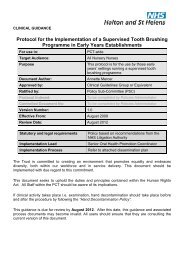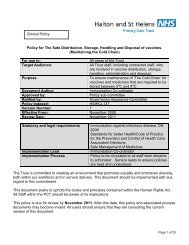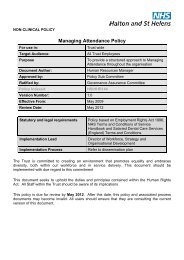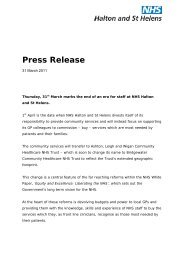Clinical Guidelines for the Safe Use of McKinley T34 Syringe Pump
Clinical Guidelines for the Safe Use of McKinley T34 Syringe Pump
Clinical Guidelines for the Safe Use of McKinley T34 Syringe Pump
You also want an ePaper? Increase the reach of your titles
YUMPU automatically turns print PDFs into web optimized ePapers that Google loves.
Who will look after my syringe pump?If you are at home, your community nurse will come in each day to replace <strong>the</strong> syringe, checkthat <strong>the</strong> needle is com<strong>for</strong>table and that <strong>the</strong>re are no problems with <strong>the</strong> medicines.If you are staying in <strong>the</strong> hospital, hospice or care home <strong>the</strong> staff <strong>the</strong>re will check your syringepump regularly to make sure it is working well. The syringe will be changed each day by <strong>the</strong>staff. They will check that <strong>the</strong> needle is com<strong>for</strong>table and that you are not having any problemswith <strong>the</strong> medicines.The medicines in your syringe pump have been prescribed by your doctor to help yoursymptoms; you do not need to do anything to <strong>the</strong> syringe pump. The medicines will continue tobe absorbed over 24 hours, helping your symptoms round <strong>the</strong> clock.What does a syringe pump look like?The syringe pump currently in use in Halton & St Helens Primary Care Trust is <strong>the</strong> <strong>McKinley</strong><strong>T34</strong> syringe pump. The pump (actuator) pushes <strong>the</strong> medicine into <strong>the</strong> giving set, through <strong>the</strong>needle and into <strong>the</strong> tissues under <strong>the</strong> skin where it is absorbed into your bloodstream. While <strong>the</strong>pump is running <strong>the</strong> indicator light will flash to let you know that it is working.The pump is lightweight and about 15cm long by 5cm tall. It may have a clear plastic cover toprotect it and may be in a fabric bag, to protect <strong>the</strong> syringe from light. Your nurse or doctor willbe able to show you <strong>the</strong> syringe pump.Some dos and don’tsThe medicines in <strong>the</strong> syringe pump will flow into your blood stream throughout <strong>the</strong> 24-hourperiod, controlling your symptoms. Any adjustments required will be made by your GP orCommunity Nurse or by <strong>the</strong> hospital or hospice staff. Do not interfere with <strong>the</strong> syringe or <strong>the</strong>pump.You must keep <strong>the</strong> syringe pump and <strong>the</strong> infusion site dry. Take care when washing or bathingto keep <strong>the</strong> syringe pump dry. If you drop it into water contact your nurse, a new syringe pumpwill be needed to be sure that your medicines are being given at <strong>the</strong> right rate.The syringe in <strong>the</strong> pump should not be exposed to direct sunlight– you should keep it in <strong>the</strong>fabric pouch to protect it from light.The syringe pump should not be exposed to extremes <strong>of</strong> heat. Avoid placing <strong>the</strong> syringe pumpnext to a heat pad, electric blanket or hot water bottle.Avoid <strong>the</strong> use <strong>of</strong> mobile phones within a metre <strong>of</strong> <strong>the</strong> pump if at all possible as <strong>the</strong>y mayinterfere with <strong>the</strong> way <strong>the</strong> pump works. If a call is unavoidable, keep <strong>the</strong> length <strong>of</strong> <strong>the</strong> calls asshort as possible.If you notice any <strong>of</strong> <strong>the</strong> following contact your nurse/GP:Page 28 <strong>of</strong> 33

















